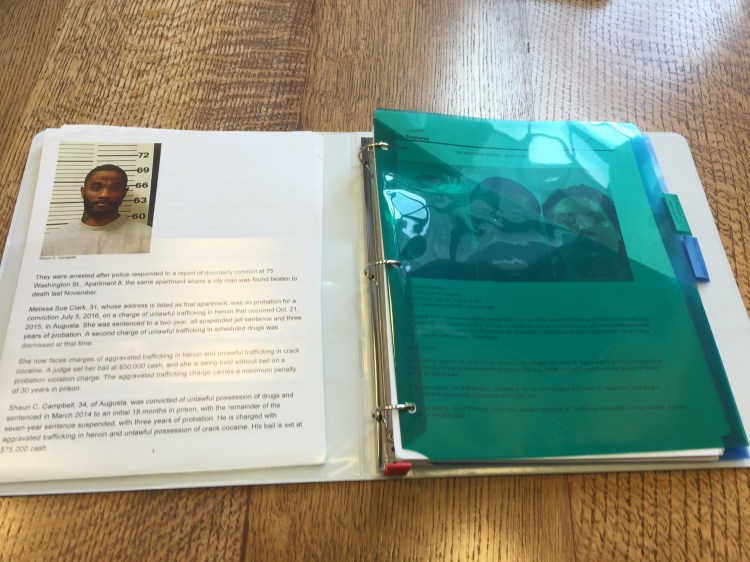AUGUSTA – Gov. Paul LePage said he has been keeping a binder of photos to prove that most of the drug dealers arrested in Maine are blacks or Hispanics, but people of those races account for only 40 percent of the photos in the binder.
The 148-page document includes press releases, newspaper clippings and jail booking and courtroom photos of people charged with trafficking heroin, methamphetamine, crack and other drugs in Maine since January. The photos in the binder show men and women of several races, and some of the pages include handwritten notes by LePage.
The governor’s office released the contents of the binder Monday, in response to numerous public records requests from the media and other organizations, including the American Civil Liberties Union of Maine.
Of the 93 people pictured in the binder, 37 appear to be either black or Hispanic, or about 40 percent of all the photos, while 56, or about 60 percent, appear to be white.
However, it’s difficult to discern the race of some of the suspects because the contents of the binder, released to the media on CDs, were scanned or photocopied in black and white, and the reproduction is uneven.
The photos do not support LePage’s own statement that “90-plus percent of those pictures” in the binder are of black or Hispanic drug dealers from Connecticut and New York.
His office has repeatedly sought to explain that LePage was specifically referring to out-of-state heroin dealers when he described the race of those arrested, not to dealers in other drugs like methamphetamine, whose photos are also in the binder.
But the photos of people facing heroin or other opioid drug charges show that only 47 percent, or 24 individuals, appear to be black or Hispanic. The remaining 53 percent, or 27 people, are white. Other press releases in the binder report the names of people charged with heroin trafficking but do not include booking mug shots.
The binder also includes a number of items with little or no drug dealing involved, such as a domestic violence case, a shooting in which the victim had heroin in his body and a home invasion where the list of items stolen included medical marijuana.
What LePage and his staff have repeatedly refused to explain is why the race of a drug dealer matters.
After reviewing the binder Monday, ACLU of Maine Executive Director Alison Beyea said it appeared LePage had “greatly” exaggerated the information in his own binder when he used the 90 percent figure.
“He then used his false claims as the basis for calling people of color the enemy,” Beyea said in a prepared statement referencing an Aug. 27 LePage press conference. “Whether or not his assertions were deliberately misleading, they were dangerous and racist.”
During that press conference LePage made a reference to going to war and the color of the enemy’s uniform saying, “Look, the bad guy is the bad guy, I don’t care what color he is. When you go to war, if you know the enemy and the enemy dresses in red and you dress in blue, then you shoot at red.”
LePage then addressed House Minority Leader Ken Fredette, R-Newport, an officer who serves as a military lawyer in the Maine Air National Guard, who sat in on the August press conference. “Don’t you – Ken (Fredette) you’ve been in uniform? You shoot at the enemy. You try to identify the enemy and the enemy right now, the overwhelming majority of people coming in, are people of color or people of Hispanic origin.”
Beyea also questioned why LePage would bother to keep such an incomplete record of drug arrests in Maine.
“The governor has multiple agencies at his disposal that collect arrest data in Maine,” she said. “It is outrageous that he would rely on an incomplete collection of newspaper clippings and emails to make false, inaccurate accusations about people of color.
“It’s time for the governor to stop using people of color as a scapegoat for Maine’s drug problem, and to start proposing real solutions based on actual facts.”
In the binder, a note reads, “Why not federal charges, U.S. Attorney”. The writing appears to be in LePage’s hand and is similar to the script in handwritten notes that LePage has sent to lawmakers and others. Other notes seem to be questioning why there are not booking photos. In one note, LePage writes, “file pictures in my binder for historical value.”
Peter Steele, LePage’s communications director, said no new material had been added to the binder since the first request for it under the state’s open records law was made on Aug. 25. Steele said LePage’s attorneys seized the document and would not allow other staff to even reorganize it.
He said the delay in the release was because attorneys had to ensure there was no information in the book that would be prohibited from release, including possible crime tips from constituents. Steele said attorneys had to go through each page line-by-line and word-by-word to ensure they were only releasing public information.
It’s not clear why there was such concern over confidential information, since the entire binder consists of press statements, previously published newspaper stories and email accounts of drug arrests made public by law enforcement.
LePage first focused on the race of drug dealers in January, when he held a town hall event in Bridgton to promote his legislative agenda and responded to a question about how he was tackling the drug addiction problem. He began talking about how heroin was being brought into Maine by dealers from out of state.
“These are guys with the name D-Money, Smoothie, Shifty – these types of guys – they come from Connecticut and New York, they come up here, they sell their heroin, they go back home,” LePage said. “Incidentally, half the time they impregnate a young white girl before they leave, which is a real sad thing because then we have another issue we have to deal with down the road.”
The statement drew sharp rebukes from Democrats, civil libertarians and other observers, and the reactions reverberated across social media and drew national media attention.
In August, LePage returned to the subject when he told a North Berwick town hall audience that 90 percent of those arrested for drug dealing in Maine since January were either black or Hispanic, a claim that drew condemnation from Democratic lawmakers and others, including the ACLU of Maine.
LePage described the binder he had been keeping to demonstrate that what he said about the race of heroin dealers in Maine was factually correct, even though he had been widely criticized for making the statement.
“Let me tell you this, explain to you, I made the comment that black people are trafficking in our state, now ever since I said that comment I’ve been collecting every single drug dealer who has been arrested in our state,” LePage said at the event. “I don’t ask them to come to Maine and sell their poison, but they come and I will tell you that 90-plus percent of those pictures in my book, and it’s a three-ringed binder, are black and Hispanic people from Waterbury, Conn., the Bronx and Brooklyn.”
In the days following, LePage made several other controversial statements as he reacted to charges of racism and failed to say why race mattered when it came to addressing Maine’s opioid crime and addiction crisis. The criticisms also prompted LePage to leave an obscenity-laden voice message for Rep. Drew Gattine, D-Westbrook.
Gattine, the co-chairman of the Legislature’s Health and Human Services Committee had said LePage’s comments in North Berwick were racially charged and not helpful in solving the state’s ongoing drug crisis but LePage believed Gattine had called him a racist. LePage has since apologized to the state and to Gattine and his family but has several times since the exchange insisted he was only stating the truth about the race of drug traffickers in Maine.
On Monday, the contents of the binder indicated LePage had maintained what appeared to be an assortment of drug-related crime news, including courtroom appearances and booking mugshots, issued by county jails, with reports clipped from Maine newspaper articles or printed from online news web sites.
In all, the binder includes copies of 89 booking mug shots from various county jails from York County to Penobscot County. It also included 15 photos from news reports and one photo from the Maine Drug Enforcement Agency of evidence including weapons and drugs seized in one drug bust. Copies of the binder were reproduced in black and white, although the LePage administration was allowing individual members of the media in Maine to inspect the actual document on an appointment basis.
Initially the ACLU of Maine, which first requested access to the binder, said if LePage was accurate in his assessment of the race of drug dealers, then it appeared the state had a problem with racial profiling.
This story will be updated.
Copy the Story LinkSend questions/comments to the editors.





Success. Please wait for the page to reload. If the page does not reload within 5 seconds, please refresh the page.
Enter your email and password to access comments.
Hi, to comment on stories you must . This profile is in addition to your subscription and website login.
Already have a commenting profile? .
Invalid username/password.
Please check your email to confirm and complete your registration.
Only subscribers are eligible to post comments. Please subscribe or login first for digital access. Here’s why.
Use the form below to reset your password. When you've submitted your account email, we will send an email with a reset code.